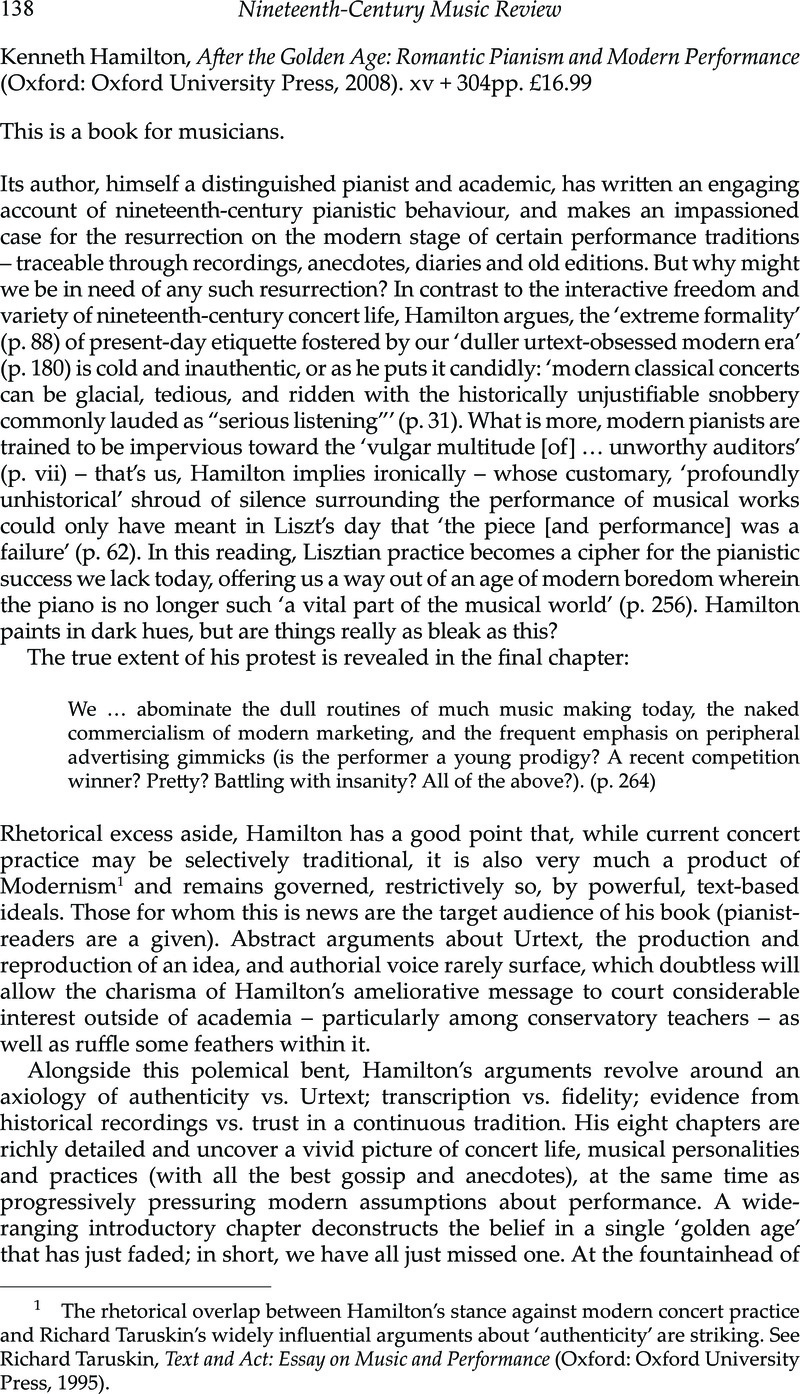No CrossRef data available.
Article contents
Kenneth Hamilton, After the Golden Age: Romantic Pianism and Modern Performance (Oxford: Oxford University Press, 2008). xv + 304pp. £16.99
Published online by Cambridge University Press: 13 April 2011
Abstract

- Type
- Book Reviews
- Information
- Copyright
- Copyright © Cambridge University Press 2010
References
1 The rhetorical overlap between Hamilton's stance against modern concert practice and Richard Taruskin's widely influential arguments about ‘authenticity’ are striking. See Taruskin, Richard, Text and Act: Essay on Music and Performance (Oxford: Oxford University Press, 1995)Google Scholar.
2 One explanation for why Liszt may sit at the start of a cycle of ‘golden ages’ is the extent to which the acceleration of a particular brand of journalism was responsible for constructing public images of him. This has recently been explored, in different ways, by Susan Bernstein and Dana Gooley. See Bernstein, , Virtuosity of the Nineteenth-Century: Performing Music and Language in Heine, Liszt, and Baudelaire (Berkeley, CA: Stanford University Press, 1998)Google Scholar; Gooley, , The Virtuoso Liszt (Cambridge: Cambridge University Press, 2004): esp. 18–77Google Scholar.
3 See Kossak, Ernst,‘Einige Worte über Improvisation’, Berliner Musik-Zeitung Echo 41 (10 Oct. 1852): 323.Google Scholar
4 This was something I explored recently in relation to Liszt's ‘Dante’ sonata; see Trippett, David, ‘Après une lecture de Liszt: Virtuosity and Werktreue in the “Dante” Sonata’, 19th-Century Music 32 (2008): 52–93CrossRefGoogle Scholar.
5 ‘Il faudrait dire … que la musique virtuose est une musique sans compositeur’, in Jankélévitch, Vladimir, De la Musique au Silence: Liszt et la Rhapsodie (Paris: Flammarion, 1979): 122Google Scholar.
6 Cone, Edward T., The Composer's Voice (Berkeley and Los Angeles: University of California Press, 1974).Google Scholar
7 Barthes, Roland, ‘The Death of the Author’, in Music–Image–Text (New York: Hill and Wang, 1978): 146 (emphasis added).Google Scholar
8 In a paper given on 3 November 2006 at the annual meeting of the AMS in Los Angeles, Roger Parker explored the philological tangles of dealing with multiple authorship and of incorporating evidence from recordings into the production of an edition. In his subsequently published article, Parker's premise (for Puccini's Manon) holds that ‘the neat divide between “genesis” and “reception” … can no longer be sustained’ creating a platform on which editors may ‘relax rigor in some places and make way for new incursions in others’. The result is a broad shift away from text-based authority – the ‘dream of a master text’– and a reminder to be ‘more humble when confronted by the limits of notation’. See Parker, , ‘Manon Lescaut: La Scala, 1930’, Opera Quarterly 24 (2009): 93–106CrossRefGoogle Scholar.
9 Butt, John, Playing with History (Cambridge: Cambridge University Press, 2002): 159.CrossRefGoogle Scholar
10 Cook, Nicholas ‘Between Process and Product: Music and/as Performance’, Music Theory Online 7 (2001):Google Scholar mto.societymusictheory.org/issues/mto.01.7.2/mto.01.7.2.cook. html (accessed 10 Jul. 2009).
11 Brown, Clive, Classical and Romantic Performing Practice 1750–1900 (Oxford: Oxford University Press, 1999).CrossRefGoogle Scholar
12 All of Chopin's first editions are now already available online through Chopin's First Editions Online (CFEO), directed by John Rink, and can be viewed at: www.cfeo.org. uk/dyn/index.html (accessed 12 Dec. 2009).
13 ‘[er] hatte ihnen gegenöber eine fast mystische Haltung; sie waren för ihn wie eine heilige Schrift, vom Geiste der Inspiration diktiert’. See Kolisch, , ‘Interpretationsprobleme bei Schoenberg’, Musiktheorie 3 (2009): 275Google Scholar.
14 Kolisch, ‘Musical Performance: The Realization of Musical Meaning’, in ‘Rudolf Kolisch – Aufsätze und Dokumente’, ed. Shreffler, Anne C. and Trippett, David, Musiktheorie 3 (2009): 201–7, 205Google Scholar.
15 Ferneyhough, Brian, Collected Writings, ed. Boros, James and Toop, Richard (Amsterdam: Routledge, 1995): 373.Google Scholar
16 Published as HN 717, ed. Heinemann, Ernst-Günter; preface by Eckhardt, Mária (Munich: Henle, 2004).Google Scholar




